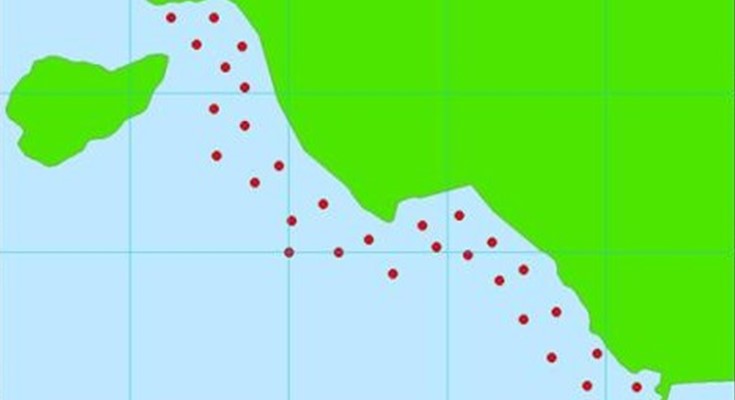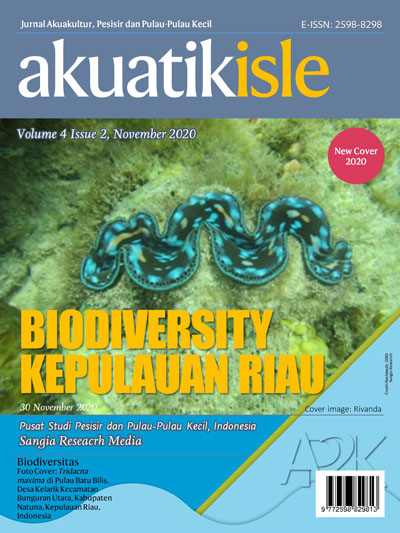Akuatikisle: Jurnal Akuakultur, Pesisir dan Pulau-Pulau Kecil
Full Length Article
Gastropod association in seagrass ecosystems Senggarang Besar waters, Riau Islands, Indonesia
Asosiasi gastropoda di ekosistem padang lamun Perairan Senggarang Besar, Kepulauan Riau, Indonesia
Highlights
Generate NLP AI by Wizdam ID.
Abstract
Penelitian bertujuan untuk mengetahui jenis dan kepadatan gastropoda, kerapatan lamun, penutupan lamun. Selain itu juga mengetahui asosiasi gastropoda di ekosistem lamun di perairan Senggarang Besar. Penelitian ini di lakukan dengan metode random sampling sebanyak 31 titik menggunakan transek kuadrat berukuran 1x1 m untuk pengamatan gastropoda dan lamun. Hasil penelitian ditemukan 12 jenis gastropoda. Nilai kepadatan gastropoda berkisar antar 0,35-2,94 individu/m2. Hasil penelitian jenis lamun yang di temukan 4 jenis lamun yaitu, Enhalus acoroides, Thalassia hemprichii, Halodule uninervis, dan Syringodium isoetifolium. Nilai kerapatan jenis lamun Enhalus acoides 14,32 individu/m2, Thalassia hemprichii 86,39 individu/m2, Halodule uninervis 21,58 individu/m2 dan Syringodium isoetifolium 3,87 individu/m2. Total kerapatan seluruh jenis lamun 126,16 individu/m2. Penutupan jenis lamun Enhalus acoides 12,63%, Thalassia hemprichii 50,96%, Halodule unnerves 13,40%, dan Syringodium isotifolium 0,29%. Penutupan total seluruh jenis lamun adalah 77,29%. Tingkat asosiasi gastropoda antar spesies sebanyak 11 spesies memiliki asosiasi negatif di antaranya adalah Leavistrombus turturela, Strombus urceus, Planaxis sulcatus, Cerithium nesioticum, Cerithium aluco, Cerithium zonatum, Pugilina cocholidium, Cronia margariticola, Muricodrupa fiscela, Pyrene epamella, Otopleura auriscati. Sedangkan 1 spesies memiliki tingkat asosiasi positif yaitu jenis Rhinoclavis aspera.
Abstract
This study aims to determine the type and density of gastropods, the density of seagrass, seagrass closure. It also knows the association gastropods in seagrass ecosystem in the waters of the Senggarang Besar. The research was conducted by random sampling method using a point 31 transect squares measuring 1x1 meters for observation gastropods and seagrass. Results of the study were found 12 species of gastropods. Gastropod density values range between 0.35-2.94 individual/m2. Results of research on the type of seagrass found 4 species of seagrass that is, Enhalus acoroides, Thalassia hemprichii, Halodule uninervis and Syringodium isoetifolium. A density value of seagrass species Enhalus acoides 14.32 individual/m2, Thalassia hemprichii 86.39 individual/m2, Halodule uninervis 21.58 individual/m2 and Syringodium isoetifolium 3.87 individual/m2. Total density of all seagrass 126.16 individual/m2. The closure of the Seagrass Enhalus acoides 12,63%, Thalassia hemprichii 50,96%, Halodule unnerves 13,40% and Syringodium isotifolium 0.29%. Total closure of all seagrass is 77,29%. The level of association between species of gastropods as many as 11 species have negative associations of which is Leavistrombus turturela, Strombus urceus, Planaxis sulcatus, Cerithium nesioticum, Cerithium Aluco, Cerithium zonatum, Pugilina cocholidium, Cronia margariticola, Muricodrupa fiscela, Pyrene epamella, Otopleura auriscati. While 1 species has a positive association level is kind of Rhinoclavis aspera.
Keywords
Introduction
Section snippets
Material and Methods
Materials and methods from the full-text PDF of this article cannot be displayed.
Results
Results from the full-text PDF of this article cannot be displayed.
Discussion
Discussion from the full-text PDF of this article cannot be displayed.
Conclusions
Conclusions from the full-text PDF of this article cannot be displayed.
Acknowledgment
Acknowledgment from the full-text PDF of this article cannot be displayed.
Competing interest
The authors declare that they have no known competing financial interests or personal relationships that could have appeared to influence the work reported in this paper.
Conflict of interest
The authors declare that the research was conducted in the absence of any commercial or financial relationships that could be construed as a potential conflict of interest.
Ethical approval acknowledgements
No ethical approval required for this article. All procedures followed were in accordance with the ethical standards of the responsible committee on human experimentation (institutional and national) and with the Helsinki Declaration of 1975, as revised in 2008 (5)
Data availability
All the data have been provided via Supplementary files. Any further information can be requested from the corresponding author via email upon reasonable request.
Appendix. Supplementary materials
Supplementary File 1: Asosiasi Gastropoda Di Ekosistem Padang Lamun Di Perairan Senggarang Besar (Research Instrument)
Declarations information
License and permission
 This work is licensed under a Creative Commons Attribution-ShareAlike 4.0 International License (https://creativecommons.org/licenses/by-sa/4.0), which permits use, sharing, adaptation, distribution and reproduction in any medium or format, as long as you give appropriate credit to the original author(s) and the source, provide a link to the Creative Commons licence, and indicate if changes were made. The images or other third party material in this article are included in the article's Creative Commons licence, unless indicated otherwise in a credit line to the material. If material is not included in the article's Creative Commons licence and your intended use is not permitted by statutory regulation or exceeds the permitted use, you will need to obtain permission directly from the copyright holder.
This work is licensed under a Creative Commons Attribution-ShareAlike 4.0 International License (https://creativecommons.org/licenses/by-sa/4.0), which permits use, sharing, adaptation, distribution and reproduction in any medium or format, as long as you give appropriate credit to the original author(s) and the source, provide a link to the Creative Commons licence, and indicate if changes were made. The images or other third party material in this article are included in the article's Creative Commons licence, unless indicated otherwise in a credit line to the material. If material is not included in the article's Creative Commons licence and your intended use is not permitted by statutory regulation or exceeds the permitted use, you will need to obtain permission directly from the copyright holder.
Publisher's Note
Sangia Publishing remains neutral with regard to jurisdictional claims in published maps and institutional affiliations.
References (1)
Arbi, U. Y. 2012. Komunitas Moluska di Padang Lamun Pantai Wori Sulawesi Utara. Bumi Lestari. 12(1): 55-65.
Arfiati, D., Endang, Y.H., & Nanik, R. B. 2019. Struktur Komunitas Makrozoobentos Pada Ekosistem Lamun di Paciran Kabupaten Lamongan Jawa Timur. Fisheries and Marine Research. 3(1): 1-7.
Aswady, I. 2008. Krustacea sebagai Konsumen di Padang Lamun. Oseana, 33(1): 1-9.
Aswandy, I., & Azkab, M. H. 2000. Hubungan fauna dengan padang lamun. Oseana, 25(3): 19-24.
Batuwael, A.W., & Rumahlatu, D. 2018. Asosiasi Gastropoda Dengan Tumbuhan Lamun di Perairan Pantai Negeri Tiouw Kecamatan Saparua Kabupaten Maluku Tengah. Biopendix. 4(2): 109-116.
Darmawan, A., Bambang, S., & Haeruddin. 2018. Analisis Kesuburan Perairan Berdasarkan Kelimpahan Fitoplankton Nitrat dan Fosfat di Perairan Sungai Bengawan Solo Kota Surakarta. Journal of Maquares. 7(1): 1-8.
Duan, F.K., Sipri, R.T, Ermelinda, M., & Ike, S. 2019. Analisis Diversitas Makro Zoobenthos Sebagai Indikator Kualitas Perairan Pantai Kelapa Lima Kota Kupang Nusa Tenggara Timur. Biotropikal Sains. 16(3): 96-107.
Fachrul, M.F. 2007. Metode Sampling Bioekologi. Penerbit Bumi Aksara. Jakarta.
Gosari, B. A.J., & Haris, A. 2012. Studi Kerapatan dan Penutupan Jenis Lamun di Kepulauan Spermonde. Ilmu Kelautan dan Perikanan. 22(3): 156-162.
Hasniar, Litaay, M., & Priosambodo, D. 2013. Bidiversitas Gastropoda di padang Lamun Perairan Mara’ Bombang Kabupaten Pinrang Sulawesi Selatan. Torani. 23(3): 127-136.
Hidayat, W., Sukra, W., & Sri, R.D. 2018. Komposisi Jenis Lamun (Seagrass) dan Karakteristik Biofisik Perairan di Kawasan Pelabuhan Desa Celukanbawang Kecamatan Gerokgak Kabupaten Buleleng Bali. Pendidikan Biologi Undiksha. 5(3): 133-145.
Hitalessy. R. B, Amin S. L., & Endang Y. H. 2015. Struktur Komunitas dan Asosiasi Gastropoda Dengan Tumbuhan Lamun di Perairan Pesisir Lamongan Jawa Timur. Pembangunan dan Alam Lestari. 6(1): 64-73.
Kawaroe, M., Aditiya, H. N., & Jurain. 2016. Ekosistem Padang Lamun. Penerbit IPB Pess. Bogor.
Kementerian Lingkungan Hidup., 2004. Keputusan Menteri Lingkungan Hidup Nomor 200 Tentang Kriteria Baku Kerusakan dan Pedoman Penentuan Status Padang Lamun Lampiran III Pedoman Penentuan Status Padang Lamun. Jakarta.
Keputusan Menteri Negara Lingkungan Hidup Nomor 51 Tahun 2004 Tentang Baku Mutu Air Laut.
Kusnadi, A., Udhi, E. H., & Teddy, T. 2009. Moluska Padang Lamun Kepulauan Kei kecil. Penerbit LIPI Press. Jakarta.
Lacap, C. D. A., Vermaat, J. E., Rollon, R. N., & Nacorda, H. M. 2002. Propagule dispersal of the SE Asian seagrasses Enhalus acoroides and Thalassia hemprichii. Marine Ecology Progress Series, 235: 75-80.
Lieftinck, M. A., & Wegner, A. M. R. 1956. Treubia, A Jurnal of Zoology, Hydrobiologi and Oceanography of the Indo-Australian Archipelago. Museum Zoologicum Bogoriense. 23:1-2.
Marni, R., Lestari, F., & Susiana, S. 2020. Ecological potential and spread distribution pattern sea cucumber Holothuria scabra and Holothuria vagabunda at Tanjungkeramat waters in Pangkil Village Bintan Regency, Indonesia. Akuatikisle: Jurnal Akuakultur, Pesisir dan Pulau-Pulau Kecil, 4(1), 7-11.
Nurjannah, M., & Irawan, H. 2013. Keanekaragaman Gastropoda Di Padang Lamun Perairan Kelurahan Senggarang Kota Tanjungpinang Provinsi Kepulauan Riau. Universitas Maritim Raja Ali Haji. Tanjungpinang.
Patty, I.P., & Husen, R. 2013. Struktur Komunitas Padang Lamun di Perairan Pulau Mantehage Sulawesi Utara. Jurnal Ilmiah Platax. 1(4): 177-186.
Rochmady, R. 2010. Rehabilitasi ekosistem padang lamun. Program Pascasarjana, Universitas Hasanuddin. Makassar.
Rochmady, R., Omar, S.B.A., & Tandipayuk, L.S. 2016. Density of mudclams Anodontia edentula Linnaeus, 1758 relation to enviromental parameters of Muna Regency. Simposium Nasional Kelautan dan Perikanan, 3(2016): 149-159.
Rogers, K. M. 2003. Stable carbon and nitrogen isotope signatures indicate recovery of marine biota from sewage pollution at Moa Point, New Zealand. Marine Pollution Bulletin, 46(7): 821-827.
Sari, P. D., Tengku, Z. U., & Riris, A, I. 2019. Asosiasi Gastropoda Dengan Lamun Seagrass di Perairan Pulau Tangkil Lampung. Penelitian Sains. 21(3): 131-139.
Saputri, J. C., Lestari, F., & Apriadi, T. 2017. Asosiasi Gastropoda Pada Vegetasi Lamun di Perairan Desa Teluk Bakau Kabupaten Bintan. [Repository]. UMRAH. Tersedia dari: http:// jurnal.umrah.ac.id./wpcontent/uploads/grav ityforms/1ec6478e525e/2017/02.Jurnal.pdf.
Sianu, N.E., Sahami, F.M., & Kasim, F. 2014. Keanekaragaman dan Asosiasi Gastropoda dengan Ekosistem Lamun di Perairan Teluk Tomini. Nike: Ilmiah Perkanan dan Kelautan. 2(4): 156-163.
Susiana, S. 2011. Diversitas dan Kerapatan Mangrove, Gastropoda dan Bivalvia di Estuari Perancak, Bali. Universitas Hasanuddin. Makassar.
Susiana, S., Apriandi, A., Rochmady, R. 2019. Identifikasi jenis kelamin siput gonggong Strombus sp. secara morfologi di perairan Madung, Tanjungpinang, Indonesia. Jurnal Ilmu dan Teknologi Kelautan Tropis, 11(3), 555-567.
Skilleter, G. A., & Underwood, A. J. 1993. Intra-and inter-specific competition for food in infaunal coral reef gastropods. Journal of experimental marine biology and ecology, 173(1): 29-55.
Wikström, S. A., & Kautsky, L. 2004. Invasion of a habitat-forming seaweed: effects on associated biota. Biological invasions, 6(2): 141-150.
Website: http://gastropods.com.
Bibliographic Information
Cite this article as:
-
Submitted
13 January 2020 -
Revised
22 May 2020 -
Accepted
10 June 2020 -
Published
17 October 2020 -
Version of record
27 May 2023 -
Issue date
30 November 2020
-
Academic subject
Fisheries; Fisheries Science
Copyright
Sangia Advertisement
Kepulauan Riau has enormous potential for marine resources. Marine biological resources ranging from mangroves, fish, shellfish, coral, and much more. However, behind such great wealth, there are also management challenges. Susiana and colleagues inventory potential resources of Tridacnidae clams in Riau Islands, Indonesia. See Rivanda et al.
Copyright © 2020 Fajeri Fajeri, Febrianti Lestari, & Susiana Susiana. Sangia Research Media and Publishing. Production and hosting by Sangia (SRM™).  This work is licensed under a Creative Commons Attribution-ShareAlike 4.0 International License.
This work is licensed under a Creative Commons Attribution-ShareAlike 4.0 International License.
Disclaimer: All claims expressed in this article are solely those of the authors and do not necessarily represent those of their affiliated organizations, or those of the publisher, the editors and the reviewers. Any product that may be evaluated in this article or claim that may be made by its manufacturer is not guaranteed or endorsed by the publisher.
Comments on this article
By submitting a comment you agree to abide by our Terms and Community Guidelines. If you find something abusive or that does not comply with our terms or guidelines please flag it as inappropriate.











